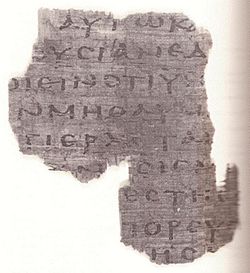Top Qs
Timeline
Chat
Perspective
Papyrus 95
New Testament manuscript From Wikipedia, the free encyclopedia
Remove ads
Papyrus 95 is an early copy of the New Testament in Greek. It is a papyrus manuscript of the Gospel of John in a fragmentary condition. It is designated by the siglum 𝔓95 in the Gregory-Aland numbering of New Testament manuscripts. The surviving texts of John are verses 5:26-29,36-38. Using the study of comparative writing styles (palaeography), it has been assigned to the early 3rd century.[1]
Remove ads
Description
The writing is in 35 lines per page.[2] The fragment should have the word πατήρ contracted (known as a nomen sacrum) in two places, however the place where these would appear is missing due to the fragmentary nature of the manuscript.[3] The manuscript is currently housed at the Biblioteca Medicea Laurenziana (PL II/31) at Florence.[4][5]
Text
The Greek text of this manuscript is considered a representative of the Alexandrian text-type. Papyrologist and biblical scholar Philip Comfort describes it as proto-Alexandrian, though the extant portion is too fragmentary for certainty.[2] It has not yet been placed in any of the Categories of New Testament manuscripts.[4]
Textual variants
- 5:27 Word-spacing analysis indicates that 10-14 letters intruded between the first two words of the verse
- 5:28: ακουσουσιν (akousousin, 'shall hear' (future tense)) becomes ακουσαντες (akousantes, 'have heard' (aorist aspect, participle)).
- 5:36: omits second 'αυτα' (auta, these) through possible homoeoteleuton.
See also
References
Images
Further reading
Wikiwand - on
Seamless Wikipedia browsing. On steroids.
Remove ads

